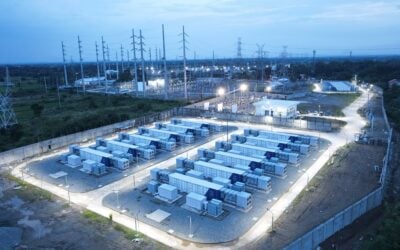The engine of a Toyota hydrogen Fuel Cell Vehicle (FCV) in Japan. Japan has invested a great deal of time, effort and money into hydrogen fuel cells, but SoCalGas' latest project is claimed to be the first real test of the related Power-to-Gas technology in the US. Image: Andy Colthorpe.
A US energy company is testing power-to-gas systems that store energy from renewable energy production, including solar power, during times of excess supply.
Southern California Gas Company (SoCalGas) launched the demonstration projects with the Energy Department's National Renewable Energy Laboratory (NREL) and the National Fuel Cell Research Center (NFCRC).
Enjoy 12 months of exclusive analysis
- Regular insight and analysis of the industry’s biggest developments
- In-depth interviews with the industry’s leading figures
- Annual digital subscription to the PV Tech Power journal
- Discounts on Solar Media’s portfolio of events, in-person and virtual
The technology uses electrolyzers to convert electricity from solar power into hydrogen gas by breaking down water into hydrogen and oxygen. The hydrogen can then be converted to methane and stored for future energy needs. It can also be used in vehicles, micro-turbines, fuel cells and other equipment.
Although commercial-scale power-to-gas systems are already used in Germany and tested worldwide, SoCalGas claims this is the first such testing in the United States.
SoCalGas claims that power-to-gas offers a longer term storage solution than batteries, which it says are limited to short-term storage and remain expensive. While there have been advances in longer duration battery types such as flow batteries, this generally remains true.
In March, at this year's Energy Storage Europe conference in Dusseldorf, Germany, the final day of the three day event hosted a major strand on power-to-gas and power-to-x technologies. According to Dr Michael Sterner of the Technical University of Applied Sciences in Regensburg, Bavaria in Germany, who chaired much of the day's events and is considered an expert in the technology, power-to-gas is likely to become increasingly more practical for long duration energy storage applications. He said this was especially likely to be true in the next few decades, as grid networks around the world start to arrive at 10% penetration from renewable energy sources, which is considered a threshold at which even modern grids start to suffer stability problems. California has committed to sourcing one third of its power from renewable sources by 2020 and state governor Jerry Brown has also proposed another target of 50% by 2030.
The demonstrations will take place at the NFCRC at the Uiversity of California, NREL's laboratories in Golden, Colorado, and in Irvine. Initial project results are expected by the end of 2015.
Patrick Lee, senior vice president, customer service, innovation and business strategy for SoCalGas, said: "A power-to-gas system can help California meet environmentally-focused energy goals and solve a major energy challenge facing our nation: how to cost-effectively store excess power from renewables to meet energy demands when the wind does not blow or the sun does not shine."
Professor Scott Samuelsen, director of the NFCRC, said: "With the extensive storage capacity of natural gas infrastructure, this project will provide important validation of the technical and economic feasibility of carbon-free energy transformation and storage.”






